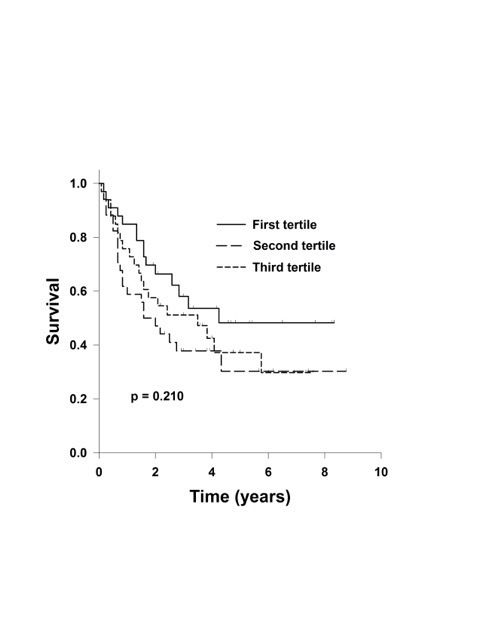|
Back to 2015 Annual Meeting Program
Sarcopenia Does Not Impact Morbidity or Survival in Patients With Resectable Esophageal Adenocarcinoma
G Paul Wright*1, Jill K. Onesti1, Chirag Patel1, Andrea M. Wolf1, 2, Mathew H. Chung1, 2
1GRMEP/Michigan State University, Grand Rapids, MI; 2Spectrum Health Medical Group, Grand Rapids, MI
Introduction: Sarcopenia has been identified as a potential predictive variable for outcomes in selective surgical procedures and disease processes. The benefit of using sarcopenia for such purposes in oncologic surgery remains unclear.
Methods: A retrospective review was conducted for all patients undergoing resection of esophageal adenocarcinoma with intention for cure at a single institution from 2006-2012. Lean psoas muscle area (LPMA) and LMPA/BMI were calculated at the level of the L4 vertebral body using preoperative computed tomography correcting for muscle density. Patients were analyzed in tertiles based on these measurements. The primary outcome measures were anastomotic leak, 90-day morbidity (Clavien grade ≥ 3), and long-term overall survival. Multivariate analyses were performed for the primary outcome measures. A p value < 0.05 was considered significant.
Results: One hundred six consecutive patients were identified and 100 patients had preoperative CT scans available for review. The mean patient age was 63±11 and 62% underwent neoadjuvant therapy. All surgical procedures were performed open and approaches included transhiatal (76%), Ivor-Lewis (11%), and three-field (13%) esophagectomy. The anastomotic leak rate was 10% and 90-day morbidity rate was 38%. Neither LPMA nor LPMA/BMI were significant predictors of anastomotic leak (LMPA - p=0.503; LPMA/BMI - p=0.268) or morbidity (LPMA - p=0.787; LPMA/BMI - p=0.528). Median overall survival was 2.8 years. Tertiles for LPMA (p=0.210) and LPMA/BMI (p=0.409) were not predictive of long-term survival (Fig. 1,2).
Conclusion: Sarcopenia is not predictive of short term outcomes or long-term overall survival following esophagectomy for esophageal adenocarcinoma.
Fig 1. Overall Survival by LPMA tertile (first = lowest)
 
Fig 1. Overall Survival by LPMA tertile (first = lowest)

Fig 2. Overall Survival by LPMA/BMI tertiles (first=lowest)
Back to 2015 Annual Meeting Program
|



